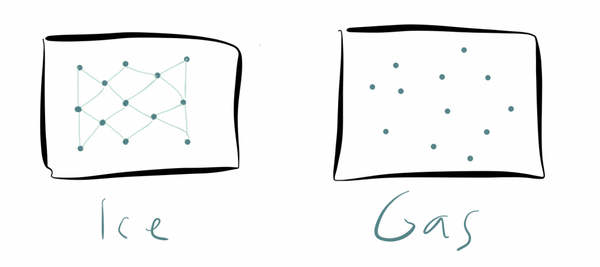Goldstone's theorem是凝聚态物理中的重要定理之一。简单来说,定理指出:每个自发对称破缺都对应一个无质量的玻色子(准粒子),或者说一个zero mode。
看过文章后,我个人理解这其实是因为我们对一个系统做整体移动时,系统实际上没有发生任何变化,而这也就对应了一个无质量的玻色子,一个零模式。
文章作者是
Jakob,
原文链接,他的博客中部分文章还有一个
非官方的中文翻译版。这个博主写的还是很浅显易懂的,用的英文也不复杂,直接看英文更好一点。博客基于WordPress,在国内可能无法正常访问,我把原文也直接贴在下面了(不知道算不上侵权...)。这学期要学固体理论,欢迎大家讨论相关知识!
为了方便我就不全文都加引用了,大家知道我是转载的就好。
Demystifying Symmetry Breaking and Goldstone's theorem
What an imperfect world it would be if every symmetry was perfect. B. G. Wybourne
What is much harder is to understand intuitively what is going on.
For example, every advanced student of physics knows
Goldstone’s theorem. The punchline of the theorem is that every time a symmetry gets broken, massless particles automatically appear in the theory. These particles are known as Goldstone bosons.
However, what almost no student knows is why this happens. In addition to the punchline, the only thing that is presented in the standard textbooks and lectures is a proof of the theorem. But knowing the punchline + knowing that you can somehow prove the punchline does not equal understanding. To express it in terms I introduced
here: what is missing is a “first layer” explanation. Students are usually only shown abstract second and third layer explanations.
I strongly believe there is always an intuitive explanation and at least Goldstone’s theorem and the famous Higgs loophole are no exceptions.
Symmetry Breaking Intuitively
Speaking colloquially, a symmetry is broken when the system we are considering is in some sense stiff. Before we consider a stiff system and why this means that a symmetry is broken, let’s consider the opposite situation first.
A gas of molecules is certainly not stiff. Consequently, we have the usual symmetries: rotational symmetry and translation symmetry.
What this means is the following:
The molecules move chaotically and if you close your eyes for a moment, I perform a global translation, i.e. move all molecules in some direction, you open your eyes again, it is impossible for you to tell that I changed something at all. The is the
definition of a symmetry: You close your eyes, then I perform a transformation on an object/system and if you can’t tell that I changed anything at all, the transformation I performed is a symmetry of the object/system.
Hence, translations are a symmetry of a gas of molecules. Equally, we can argue rotations are a symmetry of the system.
Now, systems of molecules can not only appear as a gas but also as a solid system. IF we cool down the gas it will become fluid and eventually freeze. The thing is that solid systems like an ice-crystal are stiff and possess lesssymmetry than a gas. This is the opposite of what most laypersons would suspect. For example, thinking about beautiful ice crystals, most people would agree immediately that ice is much more symmetric than water or steam.
However, this is wrong. An ice crystal can only be rotated by very special angles, like 120 degrees or 240 degrees and still looks the same. In contrast, water or steam can be rotated arbitrarily and always looks the same. “Looks the same” means as described above that you close your eyes, I perform a transformation, and if you can’t tell the difference, the transformation is a symmetry.
An important side note: The picture of the gas above has no symmetry at all. They are just randomly jumbled together with no long-range pattern. However, the gas is not well described by an image. Instead, a video would be much better. The gas molecules are floating around widely. So better imagine a series of snapshots like the one above. Such a series of snapshots will look the same if, for example, rotated.
Next, we want to understand, as promised, Goldstone’s theorem intuitively. To do this, let’s first talk about energy for a moment.
A crystal consists of molecules arranged in regular, repeating rows and columns. The molecules arrange like this because the perfect arrangement in a lattice is the configuration with the lowest energy. As noted above, symmetry is broken if the atoms are arranged like this. This means directly, that I can no longer perform move the molecules around freely like I could in a gas. It now costs energy to move molecules.
With this in mind, we are ready to understand Goldstone’s theorem.
Why do we expect Goldstone bosons when a continuous symmetry gets broken?
We just noted that symmetry breaking means that a system becomes stiff. This, in turn, means that it now costs energy to move molecules around.
However, there is no resistance if we try to move all the atoms at once by the same amount. This is a result of the previously existing translational symmetry. This observation is exactly what is made precise in Goldstone’s famous theorem.
The relation between displacements and the corresponding energy cost is called dispersion relation. In technical terms, a dispersion relation describes the connection between the wavelength λλ and the frequency ϕϕ or equivalently the energy EE. The observation mentioned above that moving all atoms at once by the same amount is a wave with infinite wavelength. The corresponding energy cost is zero because no atoms are brought closer to each other or are separated.
The interactions among the atoms are completely unaltered by such a global shift. Therefore, we have dispersion relation ϕ(λ)=1λϕ(λ)=1λ. As λλ goes to infinity, the frequency and thus the energy becomes zero. Such a “wave” with infinite wavelength is called in this context a Goldstone mode. While you can always consider waves with infinite wavelength in any system, the special thing here is that here they cost zero energy.
This is a result of the translational symmetry of the physical laws, which is only broken by the ground state, i.e. the perfect lattice configuration. Shifting the complete perfect lattice costs no energy. Only individual displacements cost energies. Such individual displacements correspond to waves with lower wavelength and hence have a non-zero frequency.
At a first sight Goldstone’s theorem is surprising. Why should moving all the atoms at once cost no energy, whereas small changes to the lattice structure cost much more energy?
The reason for this surprising fact is the translational invariance of the laws of physics and here of the background spacetime where we imagine our crystal lives in. The spacetime is everywhere the same and hence it makes no difference to which location we move our crystal. Hence, there is no energy penalty for changes that move the complete crystal at once.
In contrast, there is a huge energy penalty for displacing individual atoms in the lattice, because the perfect lattice is configuration with the lowest energy, In this sense, the ground state configuration is stiff.
So to summarize: Whenever we have a system that is described by physical laws which posses some symmetry, where the state with the lowest energy (the ground state) does not respect this symmetry, waves with infinite wavelength cost no energy. Expressed more concisely: Whenever a global symmetry gets broken by the ground state, we get Goldstone modes.
In a crystal low-frequency, phonons are the Goldstone modes.
Completely analogous, we can discuss what happens in a magnet. Above the Curie temperature, all the spins are aligned randomly and therefore we have rotational symmetry. However, below the Curie temperature the individual spins conspire and align in some direction. This leads to magnetic stiffness which means that the individual spins resist twists. However, a uniform twist of all spins costs not energy. The corresponding Goldstone modes are called spin waves.
A spin wave – inspired by Fig. 8.4 in Quantum Field Theory by Lewis H. Ryder
In the ground state below the Curie temperature, all spins are aligned along some direction. This random choice of alignment breaks the rotational symmetry. The Goldstone modes correspond to those transformations that transform the various possible ground states into each other.
It is convenient to introduce the notion “order parameter” in this context. The order parameter is a way to classify in what phase a given system is in. In the case of the ferromagnet, the overall magnetization (= the total spin vector) is the order parameter.
Above the Curie temperature all spins are directly randomly and thus the total sum of all spins is zero. However, below the Curie temperature, the spins align and we get a non-zero overall spin vector = a non-zero order parameter.
A nice example to keep all this in mind is a chair. The above observation is exactly what allows us to move all the atoms in a chair at once. Instead of allowing a deformation of the lattice structure, the 109109 atoms that make up the chair prefer to move all at once.
In a
second essay, I will try to explain which loophole Peter Higgs (and others) discovered that makes it possible to have symmetry breaking without Goldstone bosons.
- 【转载】Recommendations with Thompson Sampling (Part II)
[原文链接:http://engineering.richrelevance.com/recommendations-thompson-sampling/.] [本文链接:http://www.cnb ...
- 【转载】Bandits for Recommendation Systems (Part I)
[原文链接:http://engineering.richrelevance.com/bandits-recommendation-systems/.] [本文链接:http://www.cnblog ...
- Dirichlet's Theorem on Arithmetic Progressions 分类: POJ 2015-06-12 21:07 7人阅读 评论(0) 收藏
Dirichlet's Theorem on Arithmetic Progressions Time Limit: 1000MS Memory Limit: 65536K Total Submi ...
- 【转载】 从ACM会议看中国大陆计算机科学与国外的差距
ps: 这是一篇06年的文章,与今日的国内计算机行业学术圈环境简直是天翻地覆,很不错的history,值得mark下,今日的cs学术发展十号是坏不发表意见,但是history是值得对比,借鉴,思考 ...
- 转载:hdu 题目分类 (侵删)
转载:from http://blog.csdn.net/qq_28236309/article/details/47818349 基础题:1000.1001.1004.1005.1008.1012. ...
- ZOJ 2283 Challenge of Wisdom 数论,Dilworth Theorem,求最长反链 难度:2
Challenge of Wisdom Time Limit: 2 Seconds Memory Limit: 32768 KB Background "Then, I want ...
- 【概率论】2-3:贝叶斯定理(Bayes' Theorem)
title: [概率论]2-3:贝叶斯定理(Bayes' Theorem) categories: Mathematic Probability keywords: Bayes' Theorem 贝叶 ...
- (转载)Nim博弈论
最近补上次参加2019西安邀请赛的题,其中的E题出现了Nim博弈论,今天打算好好看看Nim博弈论,在网上看到这篇总结得超级好的博客,就转载了过来. 转载:https://www.cnblogs.com ...
- Theorem、Proposition、Lemma和Corollary等的解释与区别
Theorem:定理.是文章中重要的数学化的论述,一般有严格的数学证明. Proposition:可以翻译为命题,经过证明且interesting,但没有Theorem重要,比较常用. Lemma:一 ...
随机推荐
- 【手摸手,带你搭建前后端分离商城系统】01 搭建基本代码框架、生成一个基本API
[手摸手,带你搭建前后端分离商城系统]01 搭建基本代码框架.生成一个基本API 通过本教程的学习,将带你从零搭建一个商城系统. 当然,这个商城涵盖了很多流行的知识点和技术核心 我可以学习到什么? S ...
- Go 安装配置golint
原文链接:http://zhoubotong.site/post/3.html一. Golint介绍 Golint 是一个源码检测工具用于检测代码规范 Golint 不同于gofmt, Gofmt用于 ...
- mac安装go环境
下载pkg文件 https://golang.google.cn/dl/ sudo vim /etc/profile export GOROOT=/usr/local/go export GOPA ...
- css中伪元素before或after中content的特殊用法attr【转】
[原文]https://segmentfault.com/a/1190000002750033 CSS中主要的伪元素有四个:before/after/first-letter/first-line,在 ...
- QT/C++插件式框架、利用智能指针管理内存空间的实现、动态加载动态库文件
QT.C++插件式框架.主要原理还是 动态库的动态加载. dlopen()函数.下面为动态加载拿到Plugininstance对应指针.void**pp=(void**)dlsym(handle,&q ...
- JavaScript的9大排序算法详解
一.插入排序 1.算法简介 插入排序(Insertion-Sort)的算法描述是一种简单直观的排序算法.它的工作原理是通过构建有序序列,对于未排序数据,在已排序序列中从后向前扫描,找到相应位置并插入. ...
- Java基础系列-Lambda
原创文章,转载请标注出处:https://www.cnblogs.com/V1haoge/p/10755338.html 一.概述 JDK1.8引入了函数式编程,重点包括函数式接口.lambda表达式 ...
- poj1011 Sticks (搜索经典好题)
poj1011 Sticks 题目连接: poj1011 Description George took sticks of the same length and cut them randomly ...
- eclipse 开发常见问题集锦
问题1: eclipse导入外部项目,中文显示乱码(如下图) 方案:项目名-->右键属性-->如下图: 问题2: jsp/html页面eclipse双击打开,代码在工作区不显示(如下图:) ...
- 彻底理解RSA加密算法
RSA是非常典型的非对称加密算法 它的算法是这样的 加密是我们把明文M转化成密文C 需要用到加密运算 而解密时我们要用解密运算将密文C转化成M 从表达式中 可以看出 e和d使我们需要确定的参数 而N是 ...


